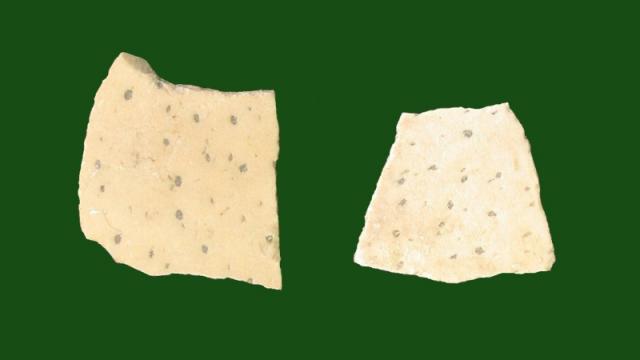Researchers working in Africa have uncovered 3.8 million-year-old protein fragments encased in an ostrich eggshell. These biological building blocks are millions of years older than the oldest DNA ever found, highlighting the possibility of recovering ancient proteins from extinct animals — and even the remains of early humans.
Ancient proteins were found “entrapped” within bits of 3.8 million-year-old ostrich eggshell. (Image: Terry Harrison)
The new study, published in eLife, represents an important breakthrough in palaeontology and ancient proteomics. Proteins are expressed by our DNA, and they represent the basic building blocks of life, forming everything from our teeth and toenails to our skin and vital organs. The researchers, led by Matthew Collins from York University, recovered the protein fragments in a 3.8 million-year-old ostrich eggshell that was found in Laetoli, Tanzania.
These protein sequences are significantly older than the oldest DNA ever extracted from fossils, which only go far back in time to about 700,000 years ago. This opens up the tantalising possibility of recovering similar proteins from the earliest human fossils; traces of human habitation in the Laetoli region date back to 3.75 million years ago. Proteins may not yield the same information as DNA, but they can still reveal much about an organism.
“Ancient proteins derived from the enamel of fossil teeth have the potential to yield important clues to the evolutionary relationships, species identity, sex, and migration patterns of early human ancestors,” said Terry Harrison, an anthropologist at New York University and a co-author of the study.
Recovery of the “entrapped” proteins in the eggshell was possible due to the way they were protected by surface minerals. The researchers were actually testing a theory to see if it’s possible to extract full sequences of proteins from hard surfaces, such as egg shells, bones and enamel — and it turns out their suspicions were right. Using a computer model, the researchers demonstrated that protein sequences do in fact survive longer when they’re stabilised by strong binding to the surface of minerals found on a hard shell or bone.
Excitingly, the researchers say their findings could translate to older fossils. “Even dinosaur eggshells will now be of interest [for chemical analysis],” noted study co-author Kirsty Penkman in the BBC.
Proteins have the potential to reveal genetic information up to 50 times older than DNA, which tends to degrade relatively quickly. By finding and isolating entire protein sequences, rather than a single instance, the researchers stand a better chance of determining biological function. Moreover, by studying these coherent sequences, the researchers can make educated inferences about the DNA that encoded for those functions. It’s basically virtual DNA.
[eLife]
